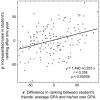Spread of academic success in a high school social network
- PMID: 23418483
- PMCID: PMC3572170
- DOI: 10.1371/journal.pone.0055944
Spread of academic success in a high school social network
Abstract
Application of social network analysis to education has revealed how social network positions of K-12 students correlate with their behavior and academic achievements. However, no study has been conducted on how their social network influences their academic progress over time. Here we investigated correlations between high school students' academic progress over one year and the social environment that surrounds them in their friendship network. We found that students whose friends' average GPA (Grade Point Average) was greater (or less) than their own had a higher tendency toward increasing (or decreasing) their academic ranking over time, indicating social contagion of academic success taking place in their social network.
Conflict of interest statement
Figures



References
-
- Wasserman S, Faust K (1994) Social Network Analysis: Methods and Applications. Cambridge, UK: Cambridge University Press. 857 p.
-
- Farmer TW, Rodkin PC (1996) Antisocial and prosocial correlates of classroom social positions: the social network centrality perspective. Social Development 5: 174–188.
-
- Bishop N (2009) The relation between peer group grades, social network structure, and secondary school academic achievement. Paper presented at the 2009 Annual Meeting of the American Sociological Association. Available: http://www.allacademic.com/meta/p308630_index.html. Accessed 31 August 2012.
-
- Add Health Data (1994-) Available: http://www.cpc.unc.edu/projects/addhealth/data. Accessed 31 Aug 2012.
-
- Fryer RG, Torelli P (2010) An empirical analysis of ‘acting white’. J Public Econ 94: 380–396.
Publication types
MeSH terms
LinkOut - more resources
Full Text Sources
Other Literature Sources

